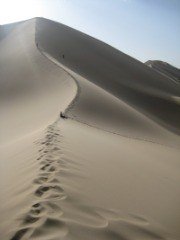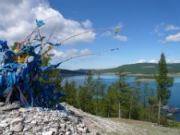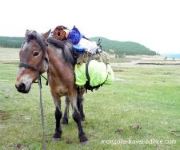|
A real guide to Ulan BatorEverybody who visits Mongolia spends time in the capital city, Ulan Bator (also spelled Ulaan Baatar). The city is modernizing quickly thanks to Mongolia's increasing market liberalization and natural resources wealth, but after 70 years of communism it still has a way to go. Ulan Bator is a bit drab, but interesting in its own way, with a few worthwhile attractions and pleasant enough to spend a few days before heading out into the more memorable countryside. Contents:
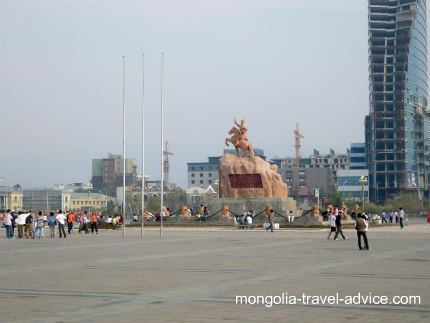
Due to a long-heralded boom in natural resources, Mongolia's share market index has doubled each of the last two years from 2009, and the country's rate of economic growth is expected to surpass China's this year. This inflow of wealth is coming through Ulan Bator, and it's reflected in the city's constantly-changing skyline. Tourist guide books gush over the luxury vehicles cruising the streets, the trendy punters filling international bars and restaurants, and the glass and steel high-rises springing up. But before you go expecting to discover the next Zurich of the Asian steppe, I stress that these changes -though wonderful and exciting- are still centered on a relatively small part of the city. The wealth is enjoyed by a privileged few, while the poverty continues for most citizens. You're probably as likely to remember the potholed streets and dull, Soviet architecture as you are the city's more cosmopolitan side. Ulaan Baatar is just east of the centre of Mongolia, making it the natural starting point for trips elsewhere in the country. It is not the most amazing city in the world but, like anywhere, those visitors who take stay longer and ease into the expat scene, or take the time and effort to meet locals and learn their language, will have a fantastic and unique experience. But for those on short stays, the Capital is more a logistics or business center to visit, spend a couple of pleasant days seeing the sights, then organize the next trip out into Mongolia's stunning wilderness. If you're stopping off on the trans-Siberian and only have 4 days in Mongolia, I recommend heading as soon as you can and spending 90% of your time out in the countryside. Ulan Bator sits 1,300 meters (i.e. 0.8 miles) above sea level, and its harsh continental climate makes it the world's coldest capital city, averaging a brisk -27 Celsius (-21F) in January. Rainfall is very low. Winter is filled with cold, crisp, sunny days, which would all be very beautiful if the city's coal-fired power stations didn't choke the air with smog. Locals say you don't know Mongolia until you've spent the winter there; no doubt they have a point, but it isn't enough to keep me there past October! Summer days get quite warm in Ulan Bator, averaging above 23C (i.e. 73F), you'll be sweating as the sun bakes the concrete around you before needing a light sweater as things cool down in the evening. Most tourists will spend their time around Peace Avenue, or Enk Taivny Orgon Chulu, which is the small but growing nucleus of the country's wealth and internationalization. The street is modernising fast, with cafes, restaurants, bars and shops popping up amidst the sprawling, Soviet-minimalist concrete buildings. It isn't the Champs Elysees, but it's an ideal place to have a beer, do some shopping, and eat some of the international cuisine you will be craving after weeks of boiled mutton out in the countryside. Crossing the road can be a hazardous event, just tag alongside some locals as they work their way between the speeding cars. Most of the action is a short walking distance from Peace Av., so it's very easy to walk around and see the sights in Ulaan Batar.
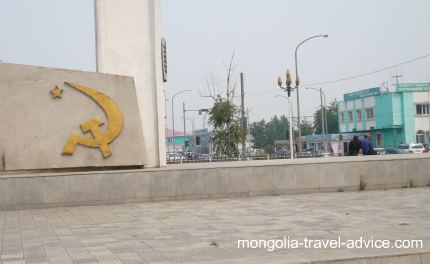
Stray far from Peace Av. and it's adjacent laneways, and the bright colors and modern shopfronts quickly depart, giving way to bleached concrete apartment blocks and dusty, empty squares. Outside the mad pedestrian and car traffic of Peace Av. and the major arterials, inner Ulan Bator often gives a feeling of vacant emptiness. At night, you'll often need a torch just to get around the back streets. This atmosphere completely transforms during the Nadaam Festival, when rural Mongolians and international visitors flood the city to see the parades and sporting spectacles. It's an exciting time to be in Ulan Bator, and while tourist numbers peak during this time, Nadaam is very much a Mongolian affair and foreigners are vastly outnumbered. Ulan Bator's population has more than doubled in the last 20 years, to over 1 million people. Growth is increasing as Mongolians depart the harsh nomadic life in search of urban opportunities and facilities. Outside the concrete apartment blocks of the inner city lie the sprawling and ever-growing Yurt Districts, where residents live in basic wood shacks or yurts (felt tents) fenced off with scrap metal. There isn't much to attract the foreign visitor out here (unless you're keen on living or volunteering there) but it is worth a look to witness the contrast in how the urban poor live compared to the wealthy minority in the inner city. Guidebooks warn of drunks and mongrel dogs in the winding alley-ways; don't go alone, or at night, and you'll be fine. Respect the pride and dignity of these people, and avoid flashing your expensive camera or thrusting it in people's faces without permission. Back to Top GUIDE IN ULAN BATOR. Hi, I just received a recommendation from some of my website visitors I got to know, who said a guy named Erdene was a fantastic guide in Ulan Bator. He has worked full time in the tourism industry (which is rare in Mongolia -usually it's just a summer job for most) and is apparently good at putting a jeep trips and adventure activities together. Erdene 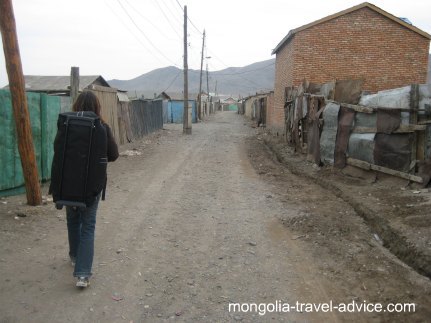
Chinggis Khan International Airport lies about 20km's (11 miles) from the city centre. A taxi from the airport should be less than $8US (10,000 Tugriks); beware this is one of the few areas in Mongolia where scams prevail: the price is negotiable, and agree on it before you climb in the taxi. Some unscrupulous taxi drivers have charged visitors $100US for a one-way trip! Don't let them increase above the agreed price once you've arrived, stay firm if they yell or get aggressive. Try to have some small $US denominations, or change some local currency upon arrival, so you don't get the "no change" excuse after handing over a 20. The train station, where those on the Trans-Siberian will arrive, is a good couple of kilometres from the city. I remember on my first visit it seemed generously close to the town centre according to the Lonely Planet map; it was a much longer walk than it appeared and I've since just grabbed a taxi when i have my bags [a consummate walker, I've encountered this issue with the scale on the Lonely Planet maps a number of times; I fancy their cartographers laugh evily in the office as they mark remote bus and train stations as only a short stroll from a town's hotels]. If your hotel or hostel is expecting you, they can arrange a pick-up for you from the airport or train station and save you the trouble. Once you arrive, it's easy to orientate yourself. Busy Peace Avenue disects the city east-to-west. It's difficult to miss, and just about everywhere the visitor is likely to stay or visit lies either on it, or within two blocks of it. Sukbaatar Square adjoins Peace Avenue's Northern side at the town's centre. It's a wide, open space that is empty most of the year outside the annual Nadaam festival and the occassional revolutionary protest. Take a stroll along the avenue, look down the nearby lanes and streets, and you'll quickly feel comfortable and well acquainted with Ulan Bator. There aren't many organized tours of the city as it's so easy to get around independently. If you're doing some research, business, or want somebody to assist with a complex transaction (i.e. buying a horse or a yurt!), ask at your hotel for an appropriate translator. In the summer, many local students are on holidays and keen to earn a dollar through translating or guiding. I'd highly recommend this as it wil only cost a few dollars, you'll be helping the locals, and it will give you fantastic insights and anecdotes that you'd never find in any tourist guidebook. Back to Top 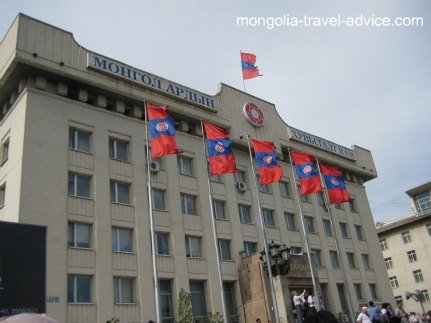
Ulan Bator has a fascinating, turbulent and violent history. Founded by Buddhist monks in the mid-17th Century, it is young compared to Karakorum, starting its life a good 300 years after the decline of Genghis Khan's empire. Originally named Urga, it was made of up of yurts and was effectively a moving monastery: for its first hundred years or so of existence, Urga moved around every couple of years or so, the inhabitants simply moving their yurts and following the course of nearby rivers. The tent city lacked the most basic amenities; travelers reported the stench of carrion and human waste could be smelled for miles. [Note Urga changed names about 8 times before settling on Ulan Bator in 1924; Westerners continued to refer to it as Urga until then, and I'll do the same below to avoid confusion.] In these times the monks tried to remain independent from the Mongol tribes contantly warring with eachother. The Qing dynasty of the Manchus eventually seized the opportunity to invade, subjugating most of Mongolia by 1750. Ulaan Baatar spent centuries under the brutal rule of the Manchus, who governed and taxed pervasively but saw little value in settling Outer Mongolia as they did with the now-Chinese provinces of Inner Mongolia and Xinjiang. The Qing dynasty slowly began to crumble into a series of warring factions, and in 1911 the Mongols opportunistically declared independence under the Buddhist Bogd Khan, who proclaimed Urga the country's capital and sought protection from the Russians. Life under the Bogd Khan was more peaceful, but he himself was no angel, entertaining his significant appetites for lust and gluttony and accumulating vast treasures while the citizens of Urga begged and starved. The Bogd Khan even had a personal zoo, and his palace is one of the few interesting buildings in Ulan Bator not demolished by the Soviets. Roy Chapman Andrews reported that the Bogd Khan had the only motor vehicle in Mongolia, delighting in wiring the battery to a long, red rope hanging from the palace wall which Buddhist pilgrims would kiss in prayer. The Khan would watch from his window and burst into laughter as devotees touched the rope and jumped in shock, certain they were receiving devine signals! In 1919 Russia was too caught up in the first World War and Bolshevik uprisings to protect Mongolia, and the Chinese warlord Xu Shuzheng invaded Urga and promptly threw the Bogd Khan into jail. Shuzheng demanded back-payments of the last 8 year's taxes since the Manchus were forced out, brutally punishing those who wouldn't pay, and reducing many of Ulaan Baatar's residents -who weren't exactly rich to begin with- to beggary.After only two years, Urga was 'liberated' by a motley bunch of Mongolians and White Russians led by Baron Ungern von Sternberg, 'The Mad Baron'. The Baron followed a bizarre Buddhist ideology, believing himself the supreme earthly leader and randomly comitting stunning acts of violence in the belief his victims would benefit from reincarnation. His madness, casual killings, complete lack of fear, and seeming ability to survive battles unscathed created an aura of terror and invincibility around him. The Baron defeated the defending Chinese and swept into Urga, freeing the Boghd Khan from prison. Urga's residents were delighted at the prospect of the Chinese Warlord being ousted, but it quickly became apparent that the Baron was far worse. What happened reads like something out of The Wild Bunch, or Cormack McCarthy's Blood Meridian, the Baron's troops took the city and began a 3-day orgy of looting, rape, torture, and killing. The Chinese troops and the city's jews were rounded up and massacred. Men, women and children were strangled, hanged from meathooks, flayed, fed to wolves, or boiled, burned, or buried alive. Any of the Baron's own men who objected to the violence would be killed themselves, while a group of deserters were hunted down and had their ears presented back to the Baron. Over 10,000 people, perhaps many more, died during the Baron's violent, 6-month reign over Urga. The Baron declared himself emperor of Russia, and the Red Army used this as an excuse to invade. The Baron and his troops rode out of Urga to meet them, suffering a number of disastrous losses. Finally, his troops eventually turned on him. He somehow escaped an assassination attempt, riding out of camp with several gunshot wounds, but was eventually found starving and bleeding out on the steppe. He was captured, tried, and executed by the Russians. Jasper Becker's The Lost Country offers a well-researched account of this horrible but fascinating period. Only 10 months after the Baron took the city, it was again captured by a Soviet-supported force led by Sukbaatar, the founder of Mongolian communism. Urga was re-named Ulan Bator ('Red Hero') in 1924 in honor of Sukbaatar's victory. His statue still dominates the town square, and his body lies enterred in the adjacent mausoleum. The Boghd Khan was allowed by the communists to continue ruling as puppet leader. He died in 1924, aged 55, and the communists announced that no successions would follow, and the country would be ruled by the Mongolian People's Party. There have been some suggestions that the Boghd Khan was secretly assassinated; such rumors aren't too difficult to believe. Over the 70 years of communism that followed, Ulan Bator's few temples and monasteries were knocked down during purges against the religeous nobility, and the yurt districts gradually gave way to the still-ubiquitous concrete apartment blocks. The Soviets comitted great transgressions against the country's religeon, culture, history, and architecture, but in many ways the purges and terrors were a continuation of the violence and subjugation that has plagued Ulan Bator since its inception. On the plus side, at least the Russians brought modernised infrastructure and services, and raised the standard of living from what was by all accounts a pretty low base. The economic liberalisation of the post-Communist era has brought rapid change and advancement to Ulan Bator. Young urban students are educated, ambitious, and have no memory of the communist days. When the ex-communist Mongolian People's Party won elections in 2008, citizens drew to the streets of Ulaan Bator in protest; rioting and looting occurred, and 5 people died. Finally, from 2009, the long-awaited mining boom really seems to be taking off. Wealth and investment are flowing into the city at an uprecendented rate, and delapidated concrete is giving way to modern steel and glass. These changes are overwhelmingly positive for Ulan Bator; let's just hope all its citizens benefit from them. July 2011 update: after only a year's absence, it's easy to see UB changing as mineral wealth flows into the city. There are a number of beautification projects (new parks and squares) underway, broken sidewalks and pot-holed streets are being repaired, about 40 cranes can be seen throughout the city (always a good indicator of economic progress), and an increasing number of well-dressed urbanites are seen on the streets and in restaurants and bars that could be at home in any European city. There is also a larger number of expensive four wheel drive vehicles (Hummers, Lexus', Toyota Landcruiser VX's) on the streets than there were previously. It does seem that a middle class is developing and that many Mongolians are benefiting from the mining boom (directly or indirectly), but ask the locals and they will talk more about the corruption of the rich and elite few, and the way the city's yurt districts have been expanding as nomads abandon the traditional life due to recent droughts and harsh winters (Zuud). For these less fortunate Mongolians, the mining boom has not brought increases in income, but has caused rises in fuel prices, increasing the cost of essential food and heating and actually lowering their standard of living. The government is under increasing pressure to redistribute wealth to all the country's citizens. Back to Top 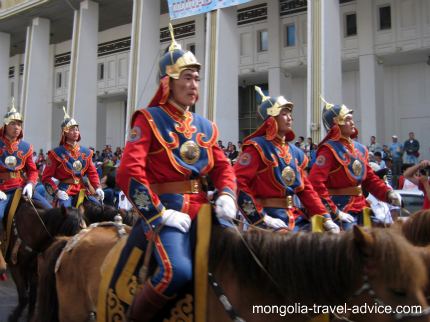
Ulan Bator has a handful of palaces and monastaries that escaped the ravages of communism, and a couple of museums worth seeing. Dedicated fans of Soviet minimalist concrete architecture will be overwhelmed by the city's rich architecture. Personally, I don't see Ulan Bator as a place of great sights, but I do find it charming and endearing in its own way. To get a sense of how the city ticks, I prefer to spend my time wondering the streets -strolling from eatery to eatery, and choosing seats where I can sit and observe what the locals are up to. It's also good idea to randomly stray a few blocks from the modernity of Peace Avenue, where only a minority of residents live their lives; walk only a few hundred metres and the Soviet-era buildings surrounding you will reveal how Ulaan Baatar's transformation is still only skin deep. The Museum of Natural History contains some exhibits on Mongolian wildlife, but most people head here for the collection of Dinosaur bones found in the Gobi. Roy Chapman Andrews shipped most of his great paleontological finds back to the United States, so your as likely to have them in New York or London. The Natural Museum of Mongolian History contains some very rare items remaining from the Mongol Empire, and their exhibit on the fall of Soviet-style communism in the 1990's is very well done. History buffs and those wanting to learn more about Mongolia will find it worth a visit. The Victims of Political Persecution Museum brings to life the horrid crimes of the Stalin era, visiting the chilling exhibits will give you an appreciation of the subjugation Mongolians had to endure under communism, and the random terror of Stalinist purges. The Winter Palace of the Bogd Khan survived communism while most of the surrounding noble's houses were destroyed. It's interesting just to see its oppulence and imagine its contrast to the living conditions of his citizens. Jasper Becker quotes Prejavalsky, a Russian explorer, on Ulan Bator at the time; there's a fair juxtaposition against the Boghd Khan's extravagance: crowds of starving beggars assemble in the marketplace; some of them, mostly poor old women, make it their final resting place. No sooner is a fresh corpse thrown into the streets than wild dogs tear it to pieces. Inside his palance, the Bogd Khan was busily engorging and entertaining himself, while filling his coffers with taxes and treasures. The winter palace was only one of four; the three others were destroyed by the communists. Click here for a detailed overview of the palace. The Gandan Monastery was one of the few in Mongolia to escape destruction. Before the communists came, Mongolia was considered the second holiest Buddhist nation after Tibet [the Dalai Lama even took refuge in Ulan Bator when the British invaded Tibet in 1904]. Once the communists arrived, the monks were murdered and the monasteries were knocked down. Gandan is quite large, and a huge golden statue has survived, but much of the interior was looted long ago. Perched on a hillside outside Ulan Bator, the Zaisan memorial is a Soviet mural which depicts the great friendship and sacrifices shared between the Russians and Mongolians (it doesn't mention the Stalinist purges). The art is quite intersting, but the attraction is more the view, a great vista out over the city and surrounding hills.Click here for a detailed overview of Zaisan memorial. There are a number of private Art Galleries popping up in Ulan Bator for those who are interested, and you can't miss the State Department Store on Peace Avenue. It embodies the increasing wealth and modernity of Mongolia and is your one-stop shopping destination; head there and marvel at the perfumes, gifts, and modern cashmere clothes on offer, while the upper floors sell some decent souveniers for tourist. Back to Top 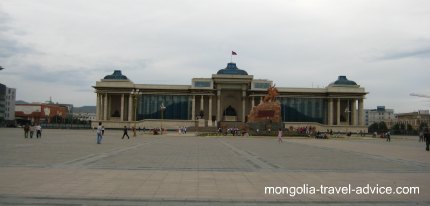
I avoid using the Lonely Planet when searching where to eat or drink. A Lonely Planet listing often drives the prices up and the owners to complacency; the locals depart, and all you'll be sharing the restaurant or bar with is a bunch of fellow tourists. Make the effort and ask around once you get there! Back to Top 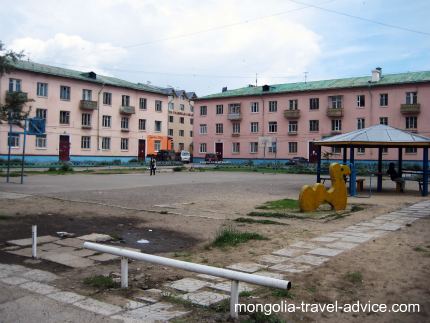
|
